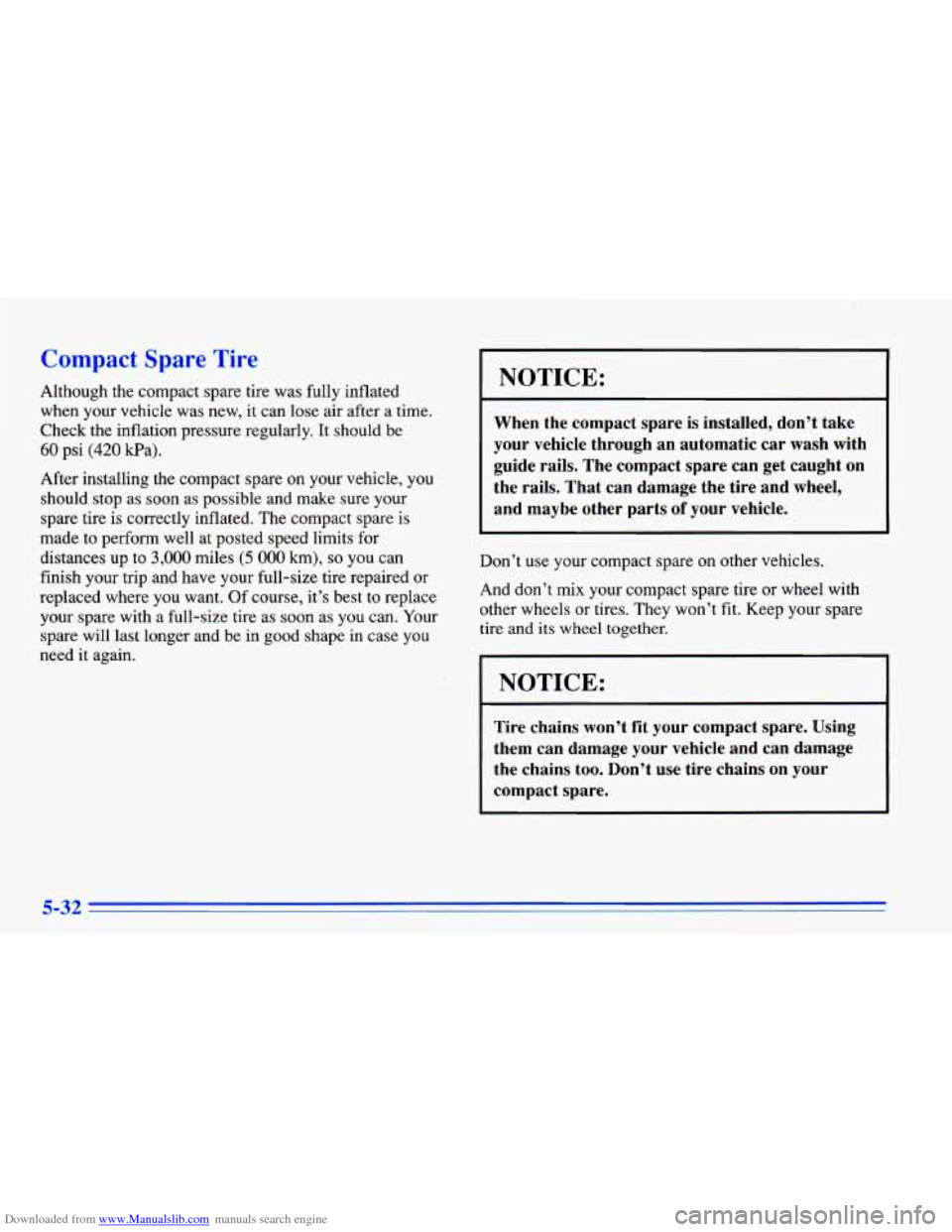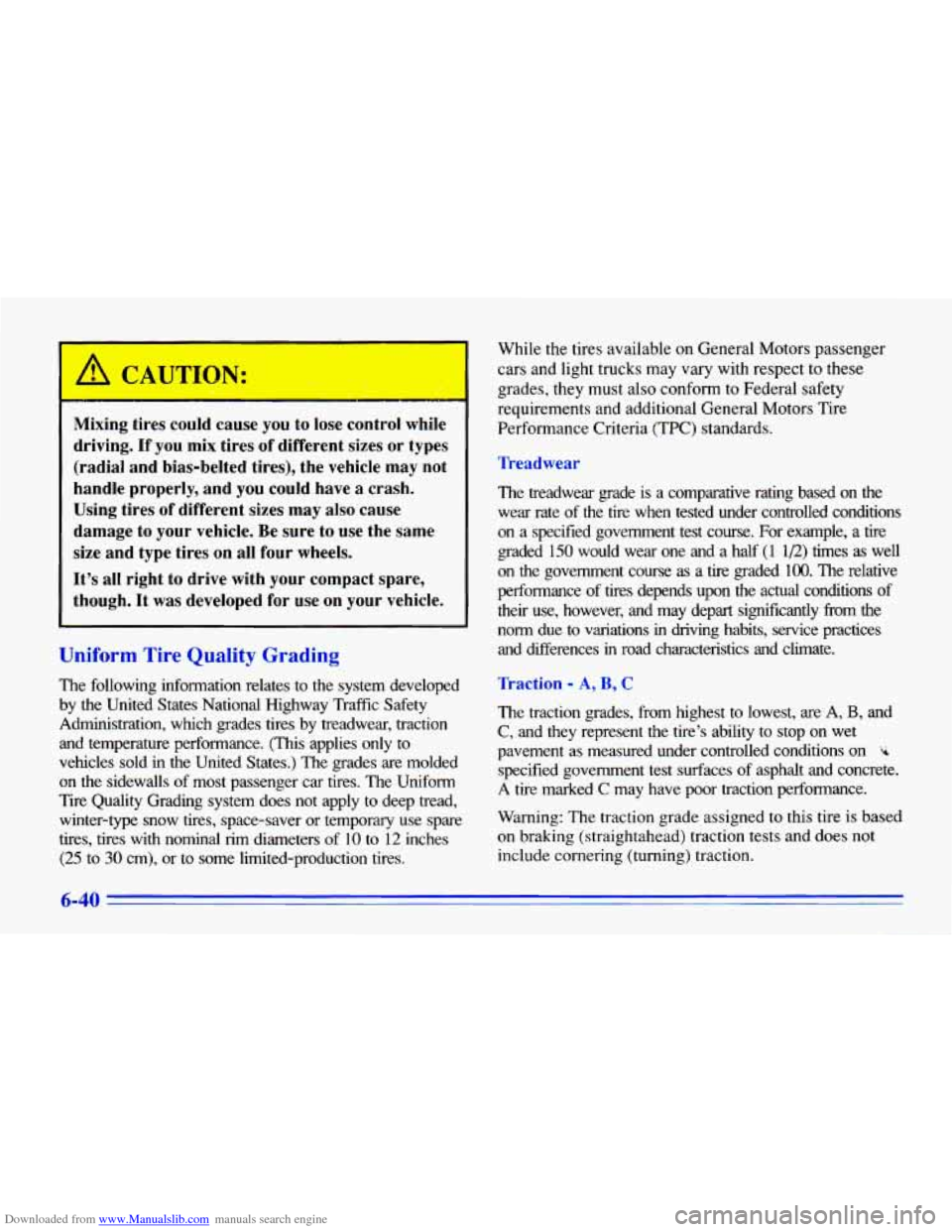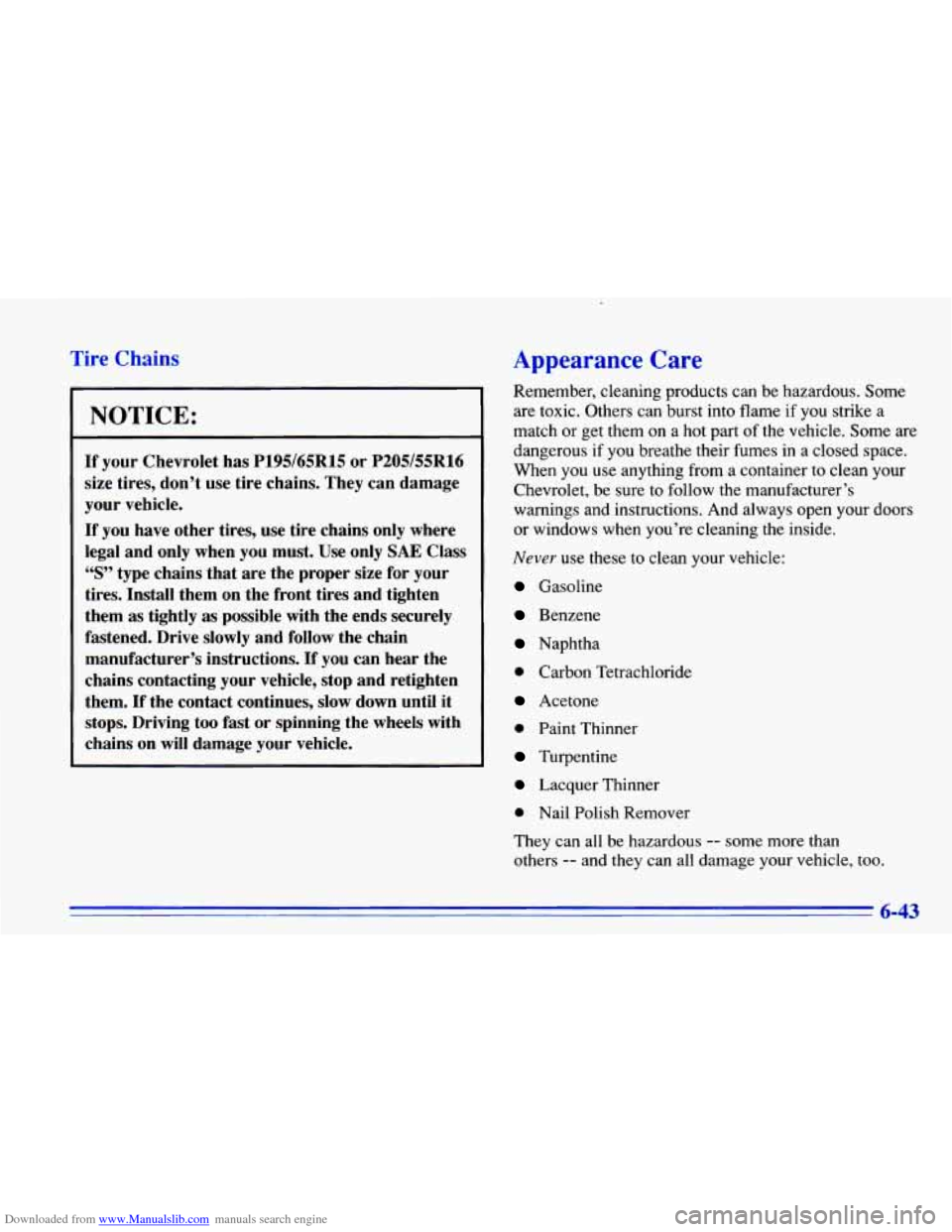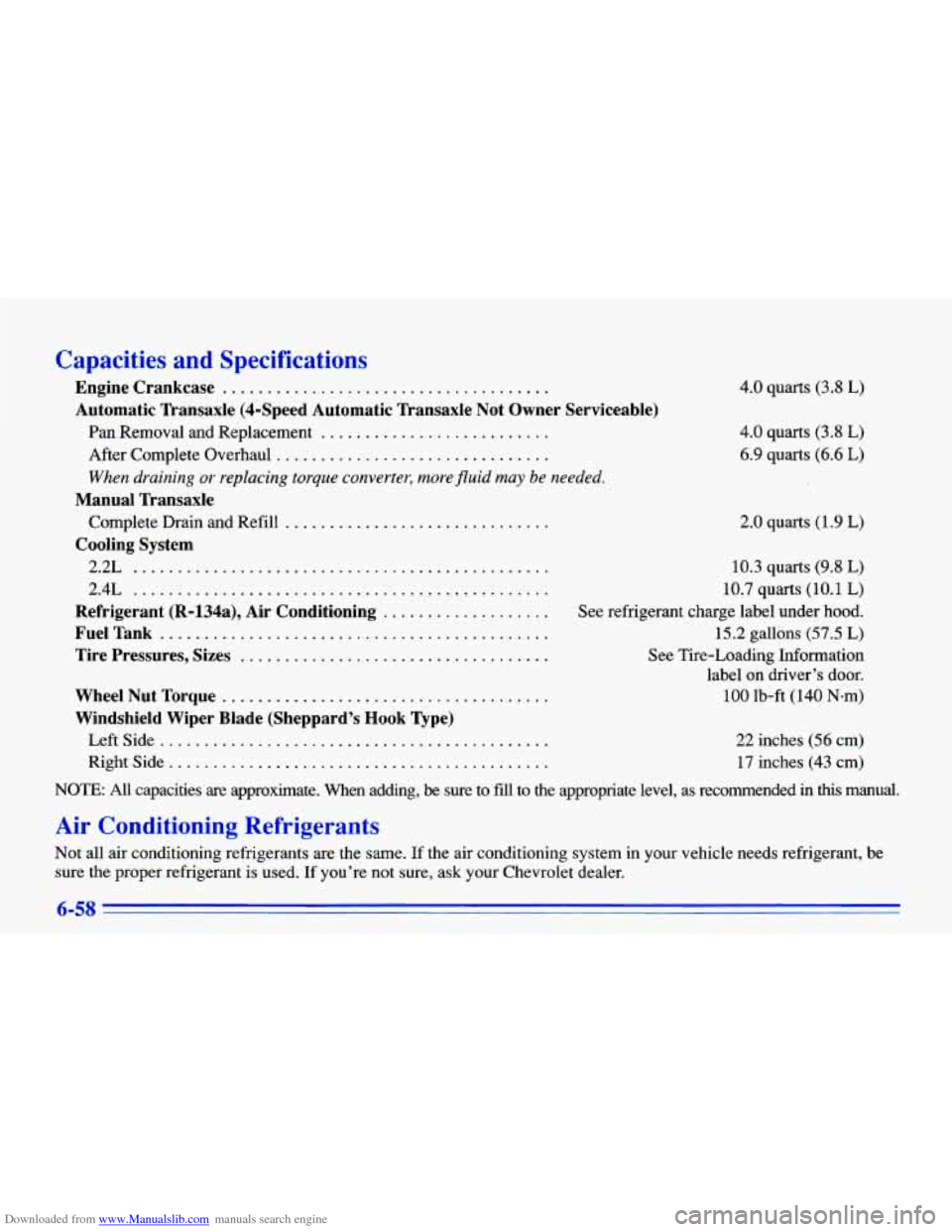1996 CHEVROLET CAVALIER wheel size
[x] Cancel search: wheel sizePage 236 of 372

Downloaded from www.Manualslib.com manuals search engine Compact Spare Tire
Although the compact spare tire was fully inflated
when your vehicle was new, it can lose air after a time.
Check the inflation pressure regularly.
It should be
60 psi (420 ea).
After installing the compact spare
on your vehicle, you
should stop as soon as possible and make sure your
spare tire is correctly inflated. The compact spare is
made to perform well at posted speed limits for
distances up to
3,000 miles (5 000 km), so you can
finish your trip and have your full-size tire repaired or
replaced where you want.
Of course, it’s best to replace
your spare with a full-size tire
as soon as you can. Your
spare will last longer and be in good shape in case you
need it again.
NOTICE:
When the compact spare is installed, don’t take
your vehicle through an automatic
car wash with
guide rails. The compact spare can get caught on
the rails. That can damage the tire and wheel,
and maybe other parts
of your vehicle.
Don’t use your compact spare
on other vehicles.
And don’t mix your compact spare tire or wheel with
other wheels or tires. They won’t fit. Keep your spare
tire and its wheel together.
I NOTICE:
Tire chains won’t fit your compact spare. Using
them can damage your vehicle and can damage
the chains
too. Don’t use tire chains on your
compact spare.
5-32
Page 278 of 372

Downloaded from www.Manualslib.com manuals search engine Uniform Tire Quality Grading
The following information relates to the system developed
by the United States National Highway Traffic Safety Administration, which grades tires by treadwear, traction
and temperature performance.
(This applies only to
vehicles sold
in the United States.) The grades are molded
on the sidewalls of most passenger car tires. The Uniform
Tire Quality Grading system does not apply
to deep tread,
A CAUTION:
Mixing tires could cause you to lose control while
driving. If you mix tires of different sizes or types
(radial and bias-belted tires), the vehicle may not
handle properly, and
you could have a crash.
Using tires of different sizes may also cause
damage to your vehicle. Be sure to use the same
size and type tires on all four wheels.
It’s all right to drive with your compact spare,
though. It was developed for use on
your vehicle.
winter-type snow tires, space-saver or temporary use spare
tires, tires with nominal rim diameters of 10 to 12 inches
(25 to 30 cm), or to some limited-production tires. While
the tires available
on General Motors passenger
cars and light trucks may vary with respect
to these
grades, they must also conform
to Federal safety
requirements and additional General Motors Tire
Performance Criteria
(TPC) standards.
Treadwear
The treadwear grade is a comparative rating based on the
wear rate of the tire when tested under controlled conditions
on a specified government test course. For example, a tire
graded 150 would wear one and a half
(1 1/2) times as well
on
the government course as a tire graded 100. The relative
performance
of tires depends upon the actual conditions of
their use, however, and may depart significantly fiom the
norm due
to variations in driving habits, service practices
and differences in road characteristics and climate.
Traction - A, B, C
The traction grades, from highest to lowest, are A, B, and
C, and they represent the tire’s ability to stop on wet
pavement as measured under controlled conditions on
k
specified government test surfaces of asphalt and concrete.
A tire marked C may have poor traction performance.
Warning: The traction grade assigned to this tire is based
on braking (straightahead) traction tests and does not
include cornering (turning) traction.
6-40
Page 281 of 372

Downloaded from www.Manualslib.com manuals search engine Tire Chains
NOTICE:
If your Chevrolet has P195/65R15 or P205/55R16
size tires, don’t use tire chains. They can damage
your vehicle.
If you have other tires, use tire chains only where
legal and only when you must. Use only
SAE Class
“S” type chains that are the proper size for your
tires. Install them on the front tires and tighten
them
as tightly as possible with the ends securely
fastened. Drive slowly and follow the chain
manufacturer’s instructions. If you can hear the
chains contacting your vehicle, stop and retighten
them.
If the contact continues, slow down until it
stops. Driving
too fast or spinning the wheels with
chains on
will damage your vehicle.
Appearance Care
Remember, cleaning products can be hazardous. Some
are toxic. Others can burst into flame if you strike a
match or get them on a hot part of the vehicle. Some are
dangerous if you breathe their fumes in a closed space.
When you use anything from
a container to clean your
Chevrolet, be sure to follow the manufacturer’s
warnings and instructions. And always open your doors
or windows when you’re cleaning the inside.
Never use these to clean your vehicle:
Gasoline
Benzene
Naphtha
0 Carbon Tetrachloride
Acetone
0 Paint Thinner
Turpentine
Lacquer Thinner
0 Nail Polish Remover
They can all be hazardous
-- some more than
others
-- and aey can all damage your vehicle, too.
6-43
Page 296 of 372

Downloaded from www.Manualslib.com manuals search engine Capacities and Specifications
Engine Crankcase .....................................
Automatic Transaxle (4-Speed Automatic Transaxle Not Owner Serviceable)
Pan Removal and Replacement ..........................
After Complete Overhaul ...............................
When draining or replacing torque converter, more fluid may be needed.
Complete Drain and Refill ..............................
2.2L ...............................................
Manual Transaxle
Cooling System
2.4L ...............................................
Refrigerant (R-l34a), Air Conditioning ...................
FuelTank ............................................
Tire Pressures, Sizes ...................................
WheelNutTorque .....................................
Windshield Wiper Blade (Sheppard’s Hook Type)
LeftSide ............................................
Rightside ...........................................
4.0 quarts (3.8 L)
4.0 quarts (3.8 L)
6.9 quarts (6.6 L)
2.0 quarts (1.9 L)
10.3 quarts (9.8 L)
10.7 quarts (10.1 L)
See refrigerant charge label under hood.
15.2 gallons (57.5 L)
See Tire-Loading Information
label on driver’s door.
100 lb-ft
(140 N-m)
22 inches (56 cm)
17 inches (43 cm)
NOTE: AU capacities are approximate. When adding, be sure to fiil to the appropriate level, as recommended in this manual.
Air Conditioning Refrigerants
Not all air conditioning refrigerants are the same. If the air\
conditioning system in your vehicle needs refrigerant, be sure the proper refrigerant is used. If you’re not sure, ask your Chevrolet dealer.
6-58